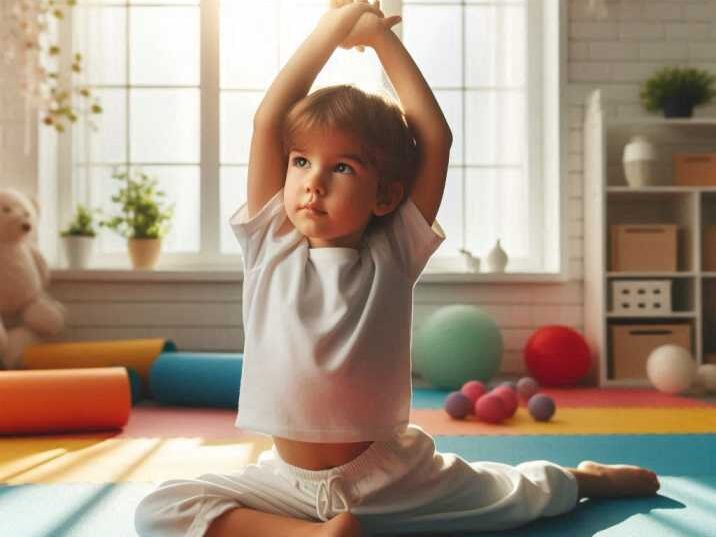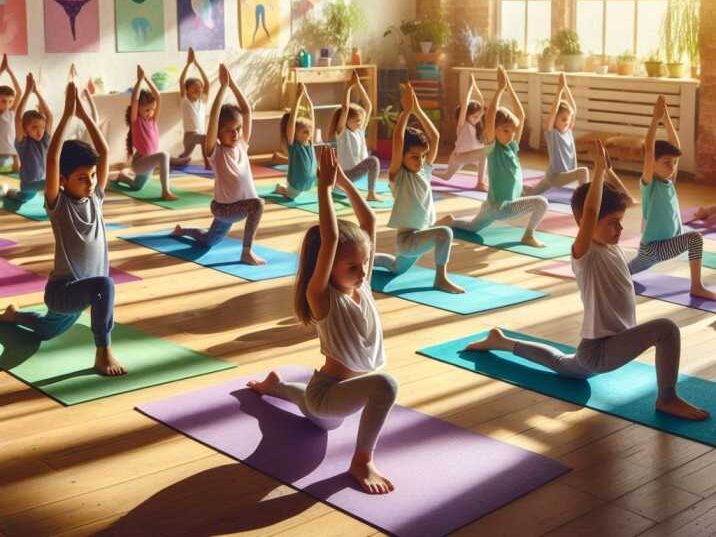Introduction
Table of Contents
Parents often ask how to help their kids become more flexible for martial arts. Flexibility is key for kicks, balance, and safe movement. Without it, kids may struggle with progress or risk injury.
Yoga for martial arts flexibility is one of the best answers. Yoga helps kids stretch safely, improve focus, and build body control. It is gentle, low-cost, and can be practiced at home.
This guide explains why yoga matters for martial arts, how it helps children, and what parents should know before starting.

What is Yoga for Martial Arts Flexibility?
Yoga is a set of stretches and breathing exercises that improve movement and strength. For martial artists, yoga helps open hips, loosen hamstrings, and build core stability.
Kids practicing martial arts like karate, taekwondo, or jiu-jitsu often need better flexibility for high kicks, rolls, or grappling. Yoga provides simple stretches that make these skills easier.
Unlike intense workouts, yoga is slow and controlled. That makes it safe for children while still giving strong results.
Benefits of Yoga for Martial Arts Flexibility
Improves Range of Motion
Kids kick higher without strain
When kids train in martial arts, many techniques require high kicks. Without enough flexibility, these kicks feel stiff and uncomfortable. Yoga stretches the hamstrings, hips, and lower back, making the legs move more freely. This means kids can raise their kicks higher while using less effort. Higher kicks also look cleaner and help kids progress faster in belt testing or competitions.
Helps with splits, sidekicks, and roundhouse kicks
Some martial arts moves need extreme flexibility, like side splits for taekwondo or high roundhouse kicks in karate. Yoga gently opens the hips and stretches the muscles around the thighs. Over time, kids can slide into splits more easily and hold strong sidekicks without wobbling. This makes techniques more powerful and reduces the risk of awkward movement. Parents often notice clear improvements after a few weeks of steady yoga practice.
Reduces stiffness from long training sessions
After intense martial arts practice, muscles can feel tight and sore. This stiffness slows recovery and can make kids less excited about training. Yoga stretches out the tension in the body, helping muscles relax and repair faster. Regular yoga keeps kids feeling fresh and ready for their next martial arts class. Parents will see that their child bounces back quicker and avoids the usual aches that come with hard training.
Lowers Risk of Injury
Flexible muscles absorb stress better
When kids practice martial arts, their muscles take on a lot of strain from kicks, jumps, and sparring. Stiff muscles can tear or cramp easily. Yoga improves flexibility, which lets muscles stretch and bend without damage. This reduces the chance of small injuries that can slow down progress.
Prevents pulled hamstrings or hip strains
High kicks and fast movements put pressure on the hamstrings and hips. If these areas are tight, kids may experience painful strains. Yoga gently stretches these muscle groups, keeping them loose and strong. With better mobility, kids can train harder while staying safe from common injuries.
Teaches safe stretching habits from a young age
Many kids rush through warm-ups or skip stretching. This makes injuries more likely during martial arts practice. Yoga introduces the habit of moving slowly, breathing deeply, and respecting body limits. When children learn these habits early, they carry them into all sports and daily life.
Builds Balance and Core Strength
Yoga poses improve body alignment
Many yoga poses, like tree pose or warrior pose, teach kids how to hold their body straight and balanced. These positions strengthen small stabilizing muscles that are often overlooked in martial arts training. With better alignment, kids stand taller and move more smoothly. Good posture also reduces unnecessary strain on the spine and joints. Over time, this makes martial arts techniques more precise and efficient.
Martial arts stances feel stronger and steadier
Strong stances are the foundation of martial arts. Without balance, kids may wobble or lose power when kicking or blocking. Yoga strengthens the legs and trains children to distribute weight evenly. This makes stances like horse stance or front stance feel more stable. As a result, kids perform techniques with greater confidence and accuracy during classes or competitions.
Core stability supports better punches and blocks
A strong core is essential for every martial arts move. Punches, kicks, and blocks all start from the center of the body. Yoga builds core muscles through poses like plank or boat pose, which challenge balance and strength together. With better core control, kids can throw faster punches, block effectively, and maintain endurance. This core strength also protects against injuries by keeping the body steady during sudden movements.
Yoga trains kids to breathe deeply
Many children breathe quickly and shallowly, especially during physical activity. Yoga teaches them to slow down and take full breaths. This calms the mind and helps kids stay relaxed even when training gets tough. Deep breathing also improves oxygen flow, which keeps the body energized.
Better breathing supports stamina in sparring
In martial arts sparring, kids often get tired quickly if they don’t control their breathing. Yoga helps them build the habit of steady, rhythmic breathing. This keeps energy levels high and reduces early fatigue. As a result, kids can last longer in practice and perform better during matches.
Increases concentration during martial arts classes
Yoga requires kids to focus on holding poses and staying still, which sharpens attention. This focus transfers directly to martial arts training. Children learn to listen closely to instructions, react faster, and stay present during drills. Better concentration makes learning techniques quicker and more effective.
Boosts Confidence
Kids feel proud when they master new poses
Yoga introduces small challenges, like balancing on one foot or holding a stretch longer. Each time kids succeed, they feel a sense of achievement. This builds self-esteem in a safe and supportive way. Parents often notice kids become more motivated after these small wins.
Confidence carries over into martial arts training
When children feel capable in yoga, they bring that confidence into martial arts practice. They try harder moves, take corrections positively, and show more determination. Confidence makes them less afraid of mistakes and more open to learning. This positive mindset helps them advance faster through ranks.
Encourages a positive attitude toward fitness
Yoga teaches kids that exercise can be calm, enjoyable, and rewarding. They begin to see fitness as something fun rather than stressful. This healthy attitude makes them more likely to stay active in martial arts and other sports. Over time, it supports a lifelong love for movement and health.
Possible Risks or Concerns
Overstretching: Forcing a pose can cause muscle strain
Kids may try to copy advanced yoga moves too quickly. If they push beyond their natural limits, muscles or joints can get strained. Gentle guidance helps them learn that stretching should feel comfortable, not painful. Parents should remind children to stop if something hurts.
Age limits: Very young kids may struggle with balance
Children under five may not yet have the coordination for certain yoga poses. Balancing poses can cause frustration or falls if rushed. It’s best to start with very simple stretches for this age group. As kids grow, they naturally handle more complex movements.
Consistency: Yoga only works if practiced regularly
Doing yoga once in a while won’t bring big changes. Flexibility improves when kids practice a little each week. Parents should help create a short routine, just like brushing teeth. Regular practice makes yoga a healthy habit rather than a rare activity.
Supervision: Kids need guidance to avoid unsafe positions
Without proper supervision, kids may bend the wrong way or hold a pose incorrectly. This can lead to discomfort or minor injuries. A parent, coach, or video guide ensures safe technique. Practicing together also keeps children motivated and supported.
Safety Tips for Parents
Start with simple poses like child’s pose, downward dog, or seated forward fold
These beginner-friendly poses stretch the body without putting stress on joints. They are easy for kids to copy and help build confidence. Once children master these, they can slowly add harder poses. Keeping things simple at first makes yoga safe and enjoyable.
Practice for 10–15 minutes, 2–3 times a week
Short, regular sessions are more effective than long, rare ones. Kids don’t need an hour of yoga to see results. A few minutes of focused stretching is enough to boost flexibility. This also prevents boredom and keeps the practice consistent.
Use a yoga mat for safety and comfort
A yoga mat prevents slipping on hard floors. It also gives cushioning for knees, elbows, and the back. This makes practice safer and more comfortable for kids. A dedicated mat also signals that yoga time is special and focused.
Always warm up before martial arts or yoga practice
Jumping into deep stretches without warming up can strain cold muscles. A few minutes of light movement, like jogging in place or arm circles, prepares the body. Warm muscles stretch better and stay safer. This habit teaches kids to respect their body’s needs.
Encourage breathing slowly instead of rushing through poses
Kids often hold their breath or move too fast. Slow breathing helps them relax and stretch deeper. It also reduces stress and improves focus. Parents can guide by breathing along with their child during practice.
Join your child for family yoga sessions
Practicing together makes yoga more fun and motivating for kids. It also gives parents a chance to model good habits. Family yoga creates bonding time while improving health for everyone. Children are more likely to stay consistent when parents join in.
Yoga vs. Regular Stretching
| Aspect | Yoga | Regular Stretching |
|---|---|---|
| Focus | Combines breath and movement | Focuses only on muscle length |
| Benefits | Flexibility, balance, relaxation | Basic flexibility |
| Best For | Martial arts performance and calmness | Quick warm-ups |
| Safety | Gentle, controlled | Can be rushed if unsupervised |

Conclusion
Yoga for martial arts flexibility gives kids a strong advantage. It helps them kick higher, stay safe from injuries, and feel more confident. Parents can support their child’s training by adding short yoga sessions at home.
Flexibility is not about forcing the body, it is about steady progress. With yoga, kids can enjoy martial arts more and grow stronger over time.
FAQs
1. Can kids really do yoga safely?
Yes, yoga is safe if kids follow age-appropriate poses and practice with guidance.
2. How soon will yoga improve martial arts flexibility?
Most kids feel results in 4–6 weeks if they practice consistently.
3. What age should kids start yoga?
Kids as young as 5 can try simple poses. Older children may progress faster.
4. Do kids need a yoga teacher?
Not always. Parents can use online videos or join beginner classes together.
5. Can yoga replace martial arts stretching?
No, but it complements it. Yoga builds deeper flexibility that martial arts alone may not.
